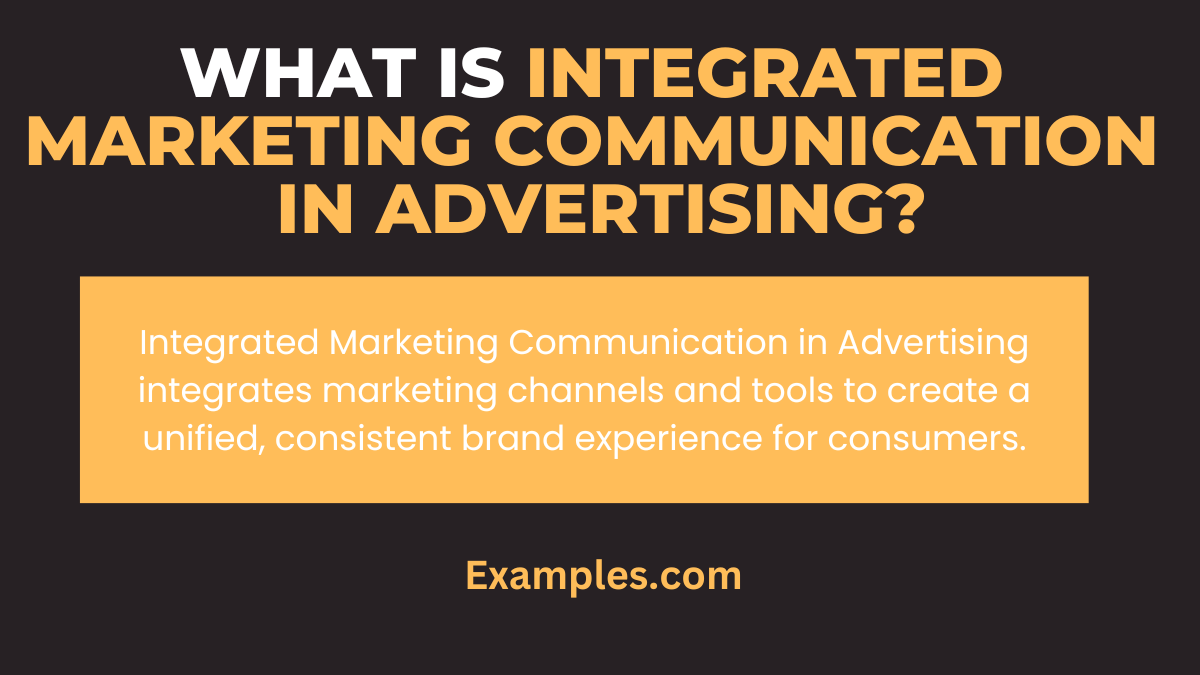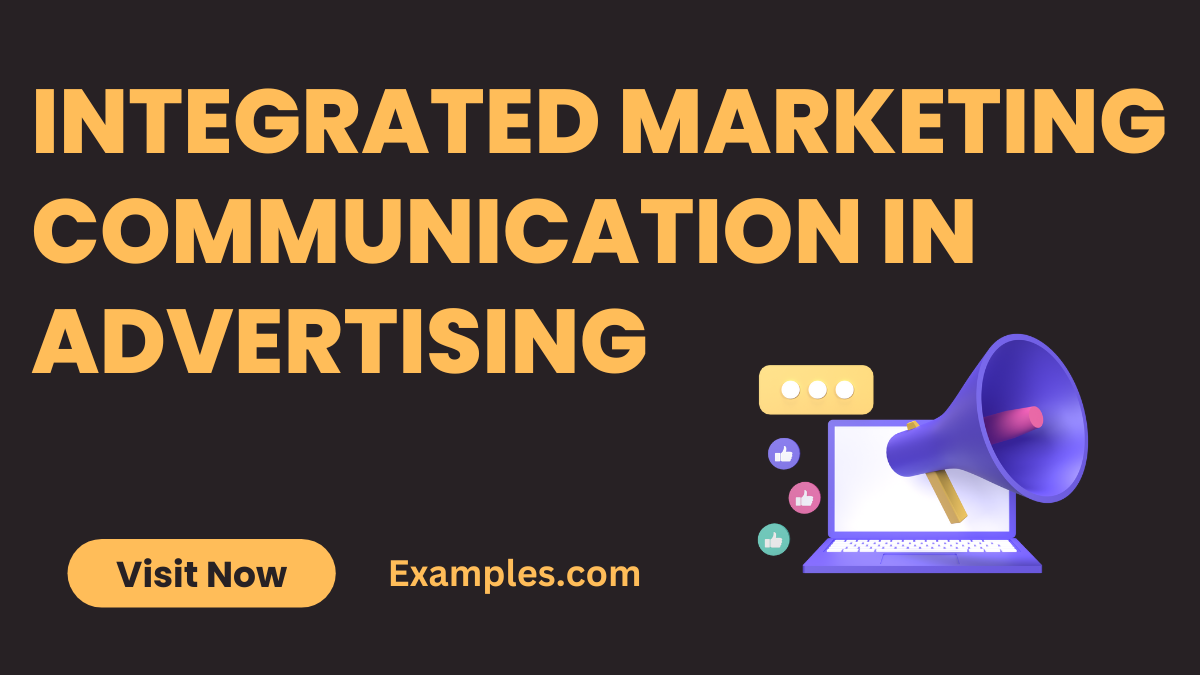19+ Integrated Marketing Communication in Advertising Examples
Integrated Marketing Communication (IMC) in advertising is a strategic approach that harmonizes all aspects of marketing communication to ensure consistency across multiple channels. This complete guide delves into varied Communication Examples, illustrating how IMC amplifies brand messaging, enhances consumer engagement, and drives successful marketing campaigns. Discover the essence and effectiveness of IMC through real-world examples, providing valuable insights for businesses and marketers.
Download Integrated Marketing Communication Plan in PDF
What is Integrated Marketing Communication in Advertising? – Meaning

Integrated Marketing Communication in Advertising refers to the coordinated use of various marketing channels and tools in a complementary way to promote a product or service. It’s about creating a unified and seamless experience for consumers to interact with a brand. IMC combines methods like digital advertising, brand messaging, and audience targeting to deliver a consistent message across all platforms, ensuring that every aspect of communication works together effectively.
What is the Best Example of Integrated Marketing Communication in Advertising?

The best example of Integrated Marketing Communication in Advertising is often seen in comprehensive campaigns that skillfully blend various elements like media planning, cross-channel marketing, and consumer engagement. A prime example is a campaign that utilizes TV commercials, social media, digital ads, and PR events cohesively. Each component complements the others, creating a unified narrative that reinforces the brand’s message, increases visibility, and engages the audience effectively across different platforms.
20 Integrated Marketing Communication in Advertising Examples

Discover 20 unique and impactful examples of Integrated Marketing Communication in advertising, showcasing diverse types, news, and perspectives. These examples demonstrate how brands effectively combine digital advertising, media planning, and consumer engagement for cohesive marketing campaigns. From innovative cross-channel marketing strategies to seamless brand messaging, each example serves as an inspiration for integrating various marketing channels to connect with audiences.
- Coca-Cola’s ‘Share a Coke’ Campaign: A personalized branding approach across print, digital, and social media.
- Nike’s ‘Just Do It’ Series: Synchronizing TV, online platforms, and outdoor advertising with consistent messaging.
- Apple’s Product Launches: Unified messaging across online, retail, and PR for new product announcements.
- McDonald’s ‘I’m Lovin’ It’ Initiative: Consistent brand message through TV commercials, digital platforms, and in-store promotions.
- Dove’s Real Beauty Campaign: Emphasizing self-esteem across social media, print, and TV advertising.
- GoPro’s User-Generated Content Strategy: Leveraging customer videos across social media, digital ads, and events.
- Starbucks’ Seasonal Promotions: Coordinated messaging across in-store displays, social media, and email marketing.
- Red Bull’s Extreme Sports Sponsorships: Integrating event marketing with digital and social media content.
- Old Spice’s Viral Video Campaigns: Blending humor in videos across social platforms and TV ads.
- Oreo’s ‘Dunk in the Dark’ Twitter Ad: Real-time marketing during the Super Bowl across social channels.
- Lego’s Movie Tie-Ins: Cross-promotion with movies and themed sets, supported by digital and retail marketing.
- Airbnb’s ‘Live There’ Campaign: Integrating social media, digital ads, and experiential marketing.
- IKEA’s Catalogue Augmented Reality App: Merging traditional catalogues with digital innovation.
- Zara’s Fast Fashion Model: Coordinating inventory, online presence, and in-store experiences.
- Spotify’s Personalized Playlists: Customized user experience promoted through social media and email.
- Netflix’s Original Content Promotion: Harmonizing content across streaming, social media, and outdoor advertising.
- Amazon Prime Day Deals: Uniting online marketing, email, and Amazon’s platform for event promotion.
- BMW’s ‘Ultimate Driving Machine’ Campaign: Consistent messaging across print, TV ads, and digital platforms.
- Google’s Doodle Campaigns: Engaging users through interactive doodles linked to search and social media.
- Chanel’s Fashion Show Live Streams: Blending luxury fashion with digital engagement across various platforms.
Integrated Marketing Communication in Advertising for Shopping
Integrated Marketing Communication (IMC) in advertising for shopping combines components like digital platforms and traditional media to enhance the shopping experience. By leveraging Components of Integrated Marketing Communications and diverse methods, IMC helps brands connect with customers more effectively. This approach is vital in sectors like tourism, rural markets, business, and hospitality.
- Amazon’s Prime Day Blitz: Utilizes email, social media, and website banners for a synchronized shopping event. Integrated Marketing Communication Methods are key in this large-scale online retail campaign.
- Walmart’s Holiday Season Strategy: Combines in-store promotions with online ads and social media. This reflects Marketing Communication in Business, offering a seamless shopping journey.
- Etsy’s Artisan Showcase: Integrates digital storytelling with direct email marketing, highlighting unique products. It demonstrates Marketing Communication in Rural Markets, connecting local artisans with a global audience.
- Airbnb Experiences Campaign: Uses online ads, social media, and email marketing to promote local tours, showcasing Marketing Communication in Tourism.
- Marriott’s Mobile App Personalization: Integrates app-based services with in-hotel experiences, an example of Marketing Communication in Hospitality.
Integrated Marketing Communication in Advertising News
In advertising news, Integrated Marketing Communication leverages various channels and functions to keep the audience informed. This approach is evident in degrees, jobs, careers, and salaries within the field, and plays a crucial role in different sectors like advertising, business, and tourism.
- Google’s Algorithm Update Announcements: Utilizes blogs, social media, and webinars to inform users. This is a prime Integrated Marketing Communication in Advertising example, impacting digital marketing strategies.
- Apple’s Product Launch Events: Combines live streaming, social media, and press releases, demonstrating Integrated Marketing Communication Methods in tech news.
- The New York Times’ Digital Expansion: Uses social media, podcasts, and email newsletters to diversify news delivery, showcasing Marketing Communication in Advertising.
- LinkedIn’s Industry Insights: Shares market trends and job data through articles and infographics, reflecting Integrated Marketing Communications Jobs, Careers, Salaries.
- National Geographic’s Environmental Campaigns: Integrates TV specials, online content, and social media for global awareness, exemplifying Marketing Communication in Tourism.
What is the Service Plan for Integrated Marketing Communication in Advertising?
A service plan for Integrated Marketing Communication (IMC) in advertising is a comprehensive strategy that combines various Integrated Marketing Communication Strategies to create a unified brand message across multiple channels. This plan should align with the core Integrated Marketing Communication Objectives, which include enhancing brand awareness, improving customer engagement, and driving sales. Key components of a service plan in IMC typically involve:
- Analysis and Research: Understanding the target market, competition, and current market trends.
- Strategy Development: Defining clear objectives, such as increasing visibility in Tourism, Public Relations, or Service Marketing sectors.
- Channel Selection: Choosing appropriate channels (social media, print, online) for Product Marketing and other specific industries.
- Content Creation: Developing engaging and relevant content tailored to each selected channel.
- Execution and Management: Implementing the plan and managing the campaign across various platforms.
- Monitoring and Evaluation: Continuously tracking results and making necessary adjustments for optimal performance.
What is the Concept of Integrated Marketing Communication in Advertising?
Integrated Marketing Communication in advertising is a concept that involves coordinating all forms of marketing communication, such as advertising, sales promotion, public relations, and direct marketing, to provide a consistent brand experience to the consumer. The concept advocates for a holistic approach to marketing, contrasting with Traditional Marketing techniques that often operate in silos. It encompasses:
- Unified Messaging: Ensuring that all communication channels deliver a consistent message, reinforcing the brand’s identity.
- Cross-Channel Synergy: Leveraging the strengths of each channel to achieve a greater impact than individual efforts could accomplish.
- Customer-Centric Approach: Focusing on creating a seamless and personalized experience for the customer, vital in sectors like Tourism and Service Marketing.
Why is Integrated Marketing Communication in Advertising Important?
The Importance of Integrated Marketing Communications lies in its ability to provide a consistent message across all platforms, creating a cohesive brand image that resonates with the audience. This approach is essential for several reasons:
- Enhanced Brand Recognition: Consistent messaging across all channels improves brand recall and recognition.
- Greater Reach and Impact: A unified approach ensures that the message reaches a wider audience more effectively, crucial in Public Relations and Product Marketing.
- Cost-Effectiveness: Integrated strategies can be more cost-effective than traditional methods, as they leverage synergies between different marketing tactics.
- Adaptability: IMC allows for flexibility and adaptability in messaging, which is critical in rapidly evolving markets like Digital Advertising and Tourism.
- Measurable Results: IMC provides more measurable outcomes, allowing businesses to assess the effectiveness of their strategies and make data-driven decisions.
What are IMC Strategies for Advertising?
IMC strategies in advertising involve coordinating Marketing Communication Channels and Components to deliver a cohesive message, ensuring all efforts work towards common Marketing Communication Objectives.
What is Integrated Communication in Marketing?
Integrated Communication in Marketing is the harmonization of all Marketing Communication Channels and processes, aiming to deliver a unified message across multiple platforms.
What are the 4 C’s of Integrated Marketing Communications?
The 4 C’s are Coherence (logical connection of all communications), Consistency (uniform messaging across channels), Continuity (ongoing communication), and Complementary (synergistic use of different components).
What is the Role of Advertisers in the IMC Program?
Advertisers in an IMC program craft and disseminate consistent messages across diverse channels, utilizing various Functions of Integrated Marketing Communications to achieve strategic goals.
Integrated Marketing Communication (IMC) in advertising is a strategic approach that aligns and integrates all aspects of marketing communication to create a cohesive and consistent message across multiple platforms. This method ensures that all forms of communication and messages are carefully linked together, enhancing the overall effectiveness of marketing campaigns.
For a deeper understanding of IMC and its importance, Harvard Business Review offers insightful articles on the evolving landscape of marketing communications Harvard Business Review – Marketing. These resources provide valuable perspectives on how integrated strategies can benefit businesses.
Another important aspect is media planning. The University of Oxford’s Saïd Business School has published research on media planning in the digital age, offering strategies for effectively allocating advertising budgets across various channels University of Oxford – Media Planning.
For a comprehensive understanding of digital advertising, MIT Sloan Management Review provides articles and research on the latest trends and techniques in the field, which are essential for a successful IMC strategy MIT Sloan Management Review – Digital Advertising.
These resources collectively offer a well-rounded perspective on Integrated Marketing Communication in Advertising, providing valuable insights into audience targeting, media planning, and the latest trends in digital advertising.
In conclusion, these examples demonstrate the power of Integrated Marketing Communication in Advertising. By harmonizing various channels and messaging, brands like Coca-Cola, Nike, and Apple have achieved consistent and compelling campaigns. Such integration enhances brand visibility, fosters engagement, and reinforces brand identity across diverse platforms, making it a vital strategy in today’s advertising landscape.



